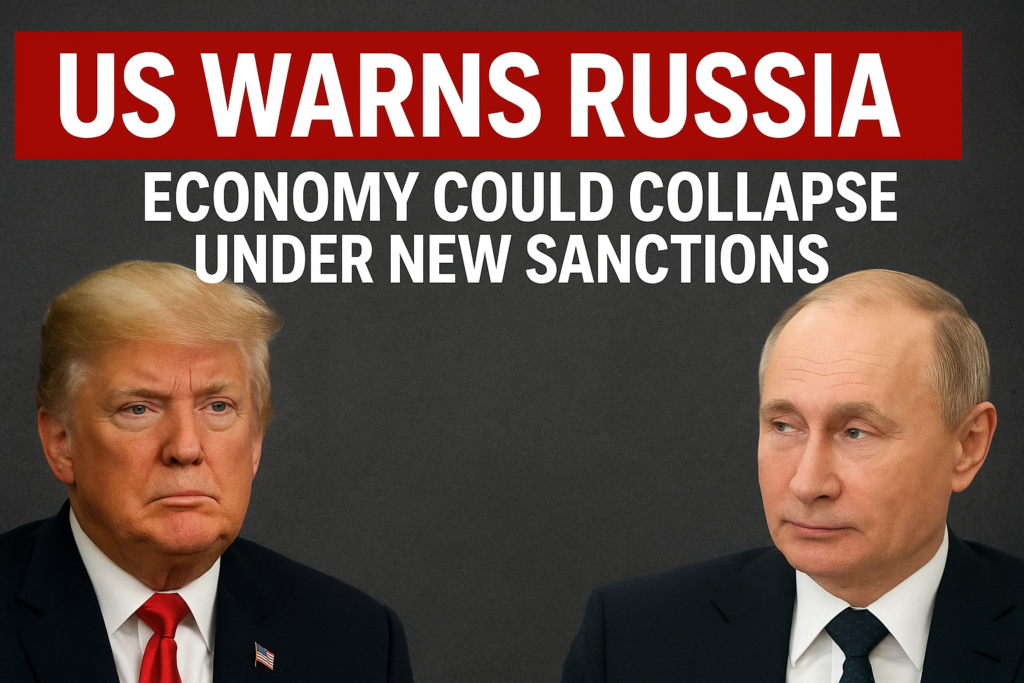The US warns Russia its economy may collapse if more sanctions are imposed, targeting oil buyers like India and China. Global trade faces new pressure.
US Warns: Russia’s Economy on the Brink if More Sanctions Hit
A New Wave of Pressure on Moscow
The economic war between the West and Russia shows no signs of cooling down. Over the weekend, the United States issued one of its most direct warnings yet—if Washington and its allies tighten the sanctions regime, Russia’s fragile economy could collapse entirely.

US Treasury Secretary Scott Bessent, speaking in a blunt and unfiltered tone on NBC’s Meet the Press, explained that the Kremlin’s ability to fund its war machine hinges on continued energy exports. If that pipeline of revenue is disrupted through tougher penalties on countries still purchasing Russian crude, Moscow’s financial stability could unravel in dramatic fashion.
His words were pointed and deliberate:
“If the US and the EU move in concert, levying fresh secondary tariffs on crude-oil purchasers, the Russian economy will be in total collapse. That collapse might be the only thing that forces President Putin to the negotiating table.”
For Washington, the message is clear—sanctions are no longer just about punishing Russia; they are about accelerating economic exhaustion as a path to ending the war in Ukraine.
India in the Crossfire of Sanctions
What makes this round of sanctions different is their global reach. Unlike earlier penalties, which primarily targeted Russia directly, the proposed measures aim at third-party buyers—countries that continue purchasing Russian oil and gas.
India, one of Russia’s largest energy partners since the invasion of Ukraine began, has already felt the heat. The United States recently imposed a 50% duty on Indian exports, adding a steep 25% surcharge to reciprocal tariffs. New Delhi was quick to react, calling the move “unjustified and unreasonable.”
For India, the issue is not merely about economics but about sovereignty. Officials have repeatedly argued that energy purchases are guided by “national interest and market dynamics”, not by external pressure. In simpler terms, India is signaling that it will not be dictated to by Washington—even as it navigates its balancing act between Moscow and the West.
The tariff row with India shows just how complex the sanctions landscape has become. Punishing Russia indirectly risks alienating partners like New Delhi, whose cooperation the US also needs in broader strategic arenas such as countering China in the Indo-Pacific.
A War of Endurance
Bessent boiled the conflict down to a grim but realistic equation: this war is not just about weapons, but about time and endurance.
“We’re in a race now. Ukraine’s military resilience versus Russia’s economic endurance. Which side breaks first?”
The US believes that while Ukraine’s soldiers hold the frontlines, economic attrition can do the heavy lifting in the background. Sanctions, banking restrictions, and shrinking oil revenues may slowly strangle Russia’s ability to sustain a prolonged conflict.
Moscow, however, has proven more resilient than many expected. Despite being cut off from Western markets, it has managed to reorient much of its oil trade toward Asia. China, India, and several other nations have provided lifelines that soften the blow. That is precisely why Washington is now turning the screws on these secondary buyers—without them, Russia’s oil revenues could shrink dramatically.
Trump’s Frustration and the “Second Phase”
President Donald Trump, never one to hide his impatience, admitted that his early hopes of brokering a quick peace deal have not materialized. His frustration has now translated into a willingness to escalate.
When pressed about whether he was prepared to launch a “second phase” of sanctions, Trump didn’t hedge his words. His answer was blunt:
“Yeah, I am.”
The details remain vague, but officials suggest that this second phase could involve wider secondary sanctions—essentially punishing companies, banks, and governments worldwide that continue doing business with Russia. Such measures would expand the economic battlefield far beyond Moscow, forcing countries to pick sides in a new financial Cold War.
For allies in Europe, the pressure is mounting as well. Washington has urged the European Union to match its stance, warning that without coordinated action, Russia may still find loopholes to keep its economy afloat.
Beyond Russia: A Global Chessboard
What becomes clear in this unfolding drama is that the sanctions are not only aimed at crippling Russia—they are also reshaping the global economic order. Every tariff and restriction reverberates across borders, affecting trade flows, energy markets, and diplomatic relationships.
Take oil, for instance. The more Russia is squeezed, the more volatile global prices become. That volatility hits not only Moscow but also consumers in Europe, Asia, and even the United States itself. Sanctions may weaken Russia, but they also test the patience of ordinary citizens worldwide who feel the pinch of rising fuel and commodity costs.
China and India, two of the largest buyers of Russian crude, now find themselves in a delicate position. Continuing purchases may invite US penalties, but cutting ties with Moscow risks their own energy security. This geopolitical tug-of-war ensures that the ripple effects of Washington’s strategy are felt far beyond the battlefields of Ukraine.
The Road Ahead: Uncertainty Rules
As sanctions pile up, the world is left with a set of difficult questions:
How long can Russia truly withstand economic isolation? The ruble has already faced volatility, inflation is biting, and capital flight continues, but Moscow insists it can adapt.
Will buyers like India and China bow to US pressure? So far, they have resisted, but the cost of defiance may rise sharply in the coming months.
Can sanctions alone end the war? History suggests that economic pressure can weaken regimes, but it rarely guarantees surrender.
For now, Washington is betting on collapse. Its strategy hinges on the belief that Russia’s economy will break before Ukraine’s military does. Yet in the unpredictable world of war and global politics, nothing is certain.
Conclusion: A World on Edge
The latest US warning is more than a threat—it’s a glimpse into how the war is being fought on multiple fronts. On the ground, soldiers battle for territory. In the halls of power, diplomats maneuver for influence. And in financial capitals from New York to New Delhi, sanctions redraw the map of global trade.
Whether Russia’s economy will indeed collapse is still unknown. But one fact is undeniable: the sanctions game is no longer just about punishing Moscow. It is about testing the world’s economic resilience, its alliances, and its willingness to endure pain for the sake of principle.
In this high-stakes race, the collapse of one economy could ripple into a shock felt everywhere. The world is watching—and waiting.
